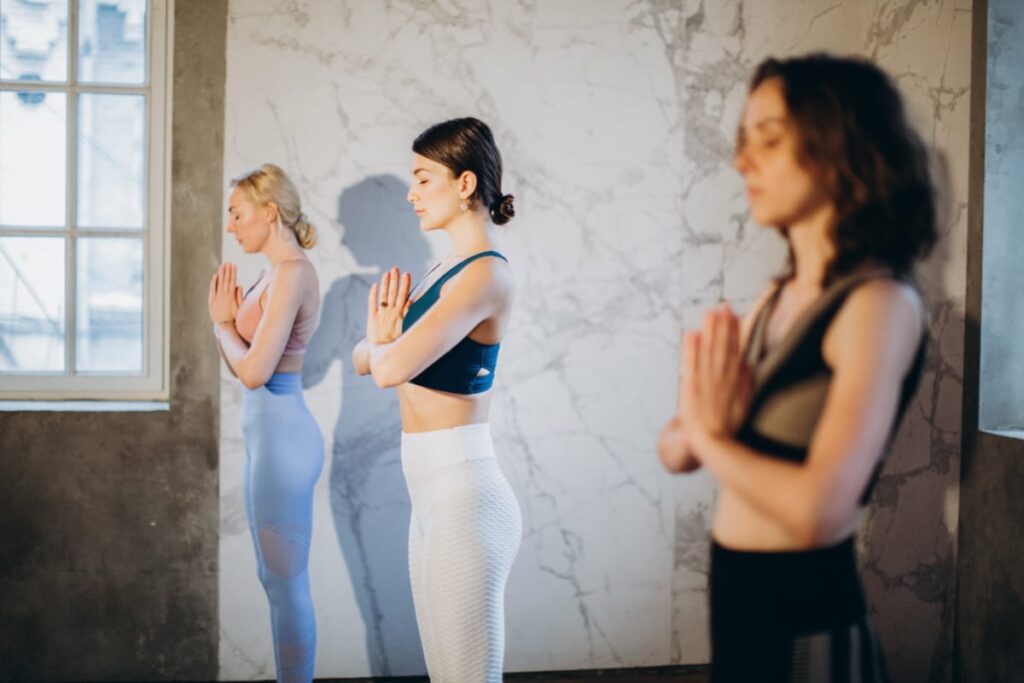SURYA NAMASKARA: A WONDERFUL SEQUENCE OF ASANAS
by Sohaila Akbar
In ancient India, the sun, being the source of life on Earth, was worshipped by many. It symbolizes spiritual consciousness. Surya means sun; namaskara means salutation. Even though Surya Namaskara is widely practised as a part of one’s Yoga routine today, it was not a traditional part of hatha yoga and was added to it much later.

Surya Namaskara comprises a dynamic set of asanas practised in a set sequence. However, it is important to know that it can be modified as per individual practitioners, which we will discuss later. To add to the spiritual aspect of Surya Namaskara, a mantra is chanted simultaneously with each posture.
Now let us see the postures that make up one round of Surya Namaskara.
Posture 1: Pranamasana or Namaskara Mudra (Prayer pose)
Keeping the eyes closed, stand straight with the feet together. Then bring your palms in Namaskara Mudra in front of your chest.
Contra indications: None
Posture 2: Hasta Uttanasana (Raised Arms Pose)
Inhale. Raise the hands up (either maintaining the namaskara mudra or keeping the palms separate) and stretch them above your head. The palms, if open, should be shoulder width apart. Go for a slight backward bend.
Contra indications: People with shoulder injuries should take care not to extend far back.
Posture 3: Padahastasana (hand to foot pose)
Exhale. Bend forward from the hips and place your palms on the mat on either side of your feet. Without rounding your upper and middle back, bring the forehead as close to the knees or shins as possible.
Contra indications: People suffering from back pain should avoid a full forward bend. They can modify the posture by slightly bending the knees and bending forward either halfway or only as much as physically comfortable. People suffering from hypertension should also bend forward only halfway, keeping the torso at a ninety-degree angle to the legs.
Posture 4: Ashwa Sanchalanasana (Equestrian Pose)
Inhale. Stretching back the right leg while simultaneously bending the left knee without changing the position of the left foot or the palms.
Contra indications: People suffering from knee or ankle pain can stretch the right leg back only as far as comfortable.
Posture 5: Phalakasana (Plank)
Exhale. Take the left leg back, placing the left foot beside the right. The pelvis remains neutral and the body is like a slightly inclined plank.
Contra indications: People with wrist and ankle injuries should modify the pose by placing both the knees on the mat.
Posture 6: Ashtanga Namaskara (Eight Limbed Pose)
Hold your breath. Without moving the palms and the feet, lower the knees, chest and chin to the floor. Keep the elbows tucked in.
Contra indications: People with acute back issues, high blood pressure or heart ailments should avoid this pose.
Posture 7: Bhujangasana (Cobra Pose)
Inhale. Keeping the hands and feet in place, slide the chest forward and raise the head and shoulders, slightly arching the back. Stretch the toes out.
Contra indications: People suffering from hernia should avoid this.
Posture 8: Parvatasana (Mountain Pose)
Exhale. Tuck your toes in and without moving the palms or the position of the feet, raise your buttocks, simultaneously lowering your head between the arms. Your torso and legs form the shape of a mountain.
Contra indication: People with high blood pressure or heart ailments should avoid this pose.
Posture 9: Ashwa Sanchalanasana (Equestrian Pose)
Inhale. Bring the left foot forward between the palms. Lower the right knee to the mat, the right toes outwards.
Contra indications: same as posture 4
Posture 10: Uttanasana (Hand to Foot pose)
Exhale. Bring the right foot forward, beside the left foot. Keeping both the legs straight, bring the forehead close to the knee without rounding the back.
Contra indications: Same as posture 3
Posture 11: Hasta Uttanasana (Raised Arms Pose)
Instructions same as posture 2.
Position 12: Pranamasana (Prayer pose)
Instructions same as posture 1.
These 12 steps complete one round of Surya Namaskara. In the second round, the same 12 steps will be practised with changes in position 4 and 9. In position 4, stretch the left leg back instead of the right, and in position 9 bring the right foot forward instead of the left.
Even though each step of Surya Namaskara has its own specific benefits, there are numerous benefits to the practice as a whole, depending upon whether the pace is slow, medium or fast.
Physical benefits of Surya Namaskara
When surya namaskara is practised in synchronisation with correct breath, it serves as a fantastic way to improve mobility and warm up the entire body before moving on to more intense asanas. Practising it slow paced will help tone the muscles and increase strength; medium pace will help in increasing flexibility; fast pace helps burn excess fat from the body and aid in weight loss.
Physiological benefits Of Surya Namaskara
A fast paced Surya Namaskara practice acts as a cardio vascular exercise, thus improving blood circulation in the body and improving cardiac health. The sequence of asanas massages the internal organs, stretching and toning the muscles. This improves the digestive, reproductive and excretory systems.
Mental health benefits Of Surya Namaskara
It helps to calm down the nervous system, improve the sense of balance and develop self confidence and discipline.
Spiritual benefits Of Surya Namaskara
We can say that Surya namaskar is a complete spiritual practice as it involves asana, pranayama and mantra japa done with a lot of awareness. It is a sort of moving meditation.
However, if Surya Namaskara is practised mindlessly with a rigid approach, it can lead to injuries that outweigh the benefits. Hence, it is wise to modify each posture as per individual capacity and physical limitations. To understand this better, let us look at some examples.
For starters, there is no set number of rounds that is perfect for everyone. It will vary depending upon one’s fitness level: strength, stamina and flexibility. For instance, if an absolute beginner aims to do 108 surya namaskaras at the first go because he or she has read about its benefits, the physical load on the body will be too much to bear and possibly result in injuries.
And individualized approach is also required if someone suffers from any temporary physical limitation or ailments. Simple examples would be if one has tight hamstrings, they might need to bend their knees a bit in Uttanasana rather than keeping them completely straight. Or someone with hypertension would bend forward only half way and not do a complete forward bend in Uttanasana. Same is the case with physical injuries; the steps need to be modified so that there is no harm to the injured part of the body.
Our anatomical differences also play a huge role in how we practise Surya Namaskara. Someone with a case of genu valgum, commonly known as ‘knock-knees’, will find keeping their feet together difficult, So, they can keep their feet hip width apart. Or if someone has shorter arms, taking the hands up with palms together will result in elevated shoulders. In this case, they can keep the palms shoulder width apart.
Friends, when we step on our mats to practise Surya Namaskara, we should keep the above points in mind, and let go of our ego and comparisons with our fellow practitioners. Celebrate the amazing practice of sun salutations, while also being mindful of your individual approach to it.
In the words of the late Yoga Guru B.K.S. Iyengar:
“Action is movement with intelligence.”
About the Author

Sohaila Akbar
Sohaila is a Yoga teacher, keen on bringing about positive changes in the lives of others through the knowledge that she has received from her teachers. Prior to this she was a school teacher working towards imparting academic, social and ecological knowledge to young learners. Sohaila is an avid reader of books and have an undying love for fiction. She prefers paperbacks and hardcovers over e-books anyday. She loves travelling, and a good cup of coffee is always welcome!
